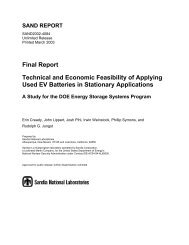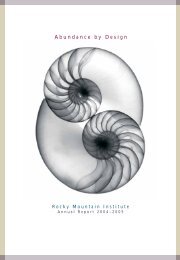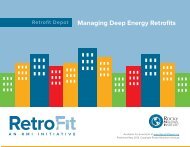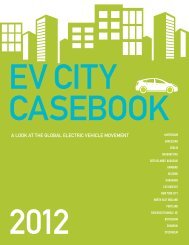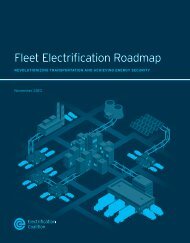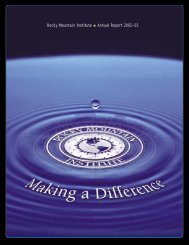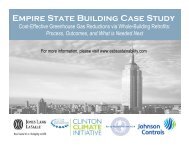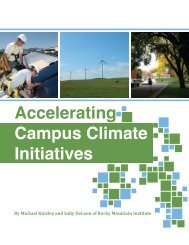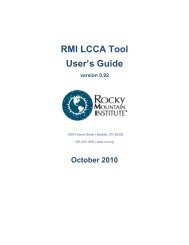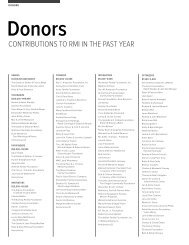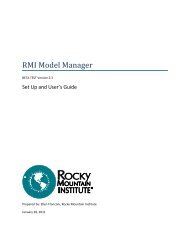Advanced Energy Efficiency, Lecture 2: Industry - Rocky Mountain ...
Advanced Energy Efficiency, Lecture 2: Industry - Rocky Mountain ...
Advanced Energy Efficiency, Lecture 2: Industry - Rocky Mountain ...
Create successful ePaper yourself
Turn your PDF publications into a flip-book with our unique Google optimized e-Paper software.
MAP/Ming Visiting Professorship, Engineering School, Stanford University, 27 March 2007<br />
CEE 173L/273L: <strong>Advanced</strong> <strong>Energy</strong> End-Use <strong>Efficiency</strong><br />
Public <strong>Lecture</strong>s in <strong>Advanced</strong> <strong>Energy</strong> <strong>Efficiency</strong>:<br />
2. <strong>Industry</strong><br />
Amory B. Lovins<br />
Chairman and Chief Scientist<br />
<strong>Rocky</strong> <strong>Mountain</strong> Institute<br />
www .rmi.org<br />
Copyright © 2007 Stanford University. All rights reserved. Distribution licensed to <strong>Rocky</strong> <strong>Mountain</strong> Institute.
American industry<br />
◊ The mightiest transformative force in history<br />
◊ Extracts raw materials, processes them into<br />
primary and secondary forms, makes those<br />
into artifacts that may be used for varying<br />
lengths of time (or none), and recycles a bit<br />
◊ Uses essentially all physical materials, >18%<br />
of freshwater withdrawals* (>60% including<br />
agriculture, a primary industry), ~31% of<br />
electricity, 35% of directly used natural gas,<br />
96% of directly used coal, 24% of oil (nearly<br />
half for feedstocks), and 32% of total energy<br />
*USGS doesn’t report how much of the public water supply goes to industry, so it’s not<br />
included here, but I’ve prorated power stations’ water withdrawals, 48% of the U.S. total,<br />
on industry’s 31% share of electricity consumption.<br />
◊ Emits 29% of U.S. fossil-fuel CO 2
First<br />
Industrial<br />
Revolution:<br />
People are<br />
scarce<br />
and nature<br />
is abundant —<br />
increase labor<br />
productivity<br />
Next<br />
Industrial<br />
Revolution:<br />
People are<br />
abundant<br />
and nature<br />
is scarce —<br />
increase resource<br />
productivity
Natural Capitalism<br />
(www.natcap.org, 1999)<br />
◊ Design principles for a world that makes sense and money<br />
◊ Productively use and reinvest in all four forms of capital<br />
◊ Two design principles about processes/products<br />
1. Radical resource productivity (tunnel through the cost barrier)<br />
2. Biomimetic production (closed loops, no waste, no toxicity)<br />
◊ Plus two design principles about business strategy<br />
3. Reward these shifts by a “solutions economy” business model<br />
4. Reinvest resulting profits back into scarcest (natural) capital<br />
◊ Result: stunning competitive advantage; do well by doing good;<br />
biggest business win is often in recruiting, retaining, and<br />
motivating the best people<br />
◊ Book and Harvard Business Review summary are free at<br />
www.natcap.org; numerous translations are available<br />
◊ Most of <strong>Rocky</strong> <strong>Mountain</strong> Institute’s revenue comes from privatesector<br />
consultancy applying these principles, chiefly in industry
The resource cycle: a massflow perspective<br />
The current system (U.S. numbers to illustrate)<br />
Natural Nutrients (Compostables)<br />
Ecosystem Services<br />
100% ≡ 20× body weight per person per day<br />
– Regeneration<br />
Natural Capital<br />
Biotic<br />
Resources<br />
17%<br />
grown<br />
100%<br />
Extraction<br />
Manufacturing<br />
Technical Nutrients (Recycling & Remanufacturing)<br />
7%<br />
Product Shipped (tons)<br />
Products in Use<br />
0.02%<br />
1% durables<br />
Disposition<br />
Waste Impact<br />
Abiotic<br />
Resources<br />
mined<br />
83%<br />
Assimilation of Waste<br />
Extractive Waste<br />
93%<br />
Manufacturing Waste<br />
Waste in System<br />
6%<br />
Waste From Use<br />
Persistent Waste From Disposal<br />
0.98%<br />
Diagrams courtesy of Don Seville and <strong>Rocky</strong> <strong>Mountain</strong> Institute<br />
~99.98% pure waste!
The resource cycle: a massflow perspective<br />
3. Get paid for doing more<br />
and Ecosystem better with Services less for<br />
longer—rewarding all of<br />
these changes<br />
A Natural Capitalist System<br />
Natural Nutrients (Compostables)<br />
Regeneration<br />
Natural Capital<br />
Biotic<br />
Resources<br />
grow<br />
n<br />
1. Improve<br />
Harvesting<br />
and<br />
Extraction<br />
<strong>Efficiency</strong>,<br />
Far Less<br />
Total<br />
Extraction<br />
Technical Nutrients (Remanufacturing & Recycling)<br />
1. Comprehensively,<br />
Radically<br />
Increased<br />
Resource<br />
<strong>Efficiency</strong><br />
2. Recapture<br />
Resources<br />
4. Reinvest<br />
in Natural<br />
Capital<br />
Extraction<br />
Manufacturing<br />
Product Shipped (tons)<br />
Products in Use<br />
Disposition<br />
Abiotic<br />
Resources<br />
mined<br />
2. Recapture<br />
Resources<br />
Extractive Waste<br />
Assimilation of Waste<br />
Waste<br />
Manufacturing Waste<br />
1. Reduce Material<br />
Per Product<br />
Waste From Use<br />
1. Increase<br />
Product<br />
Lifetime<br />
Persistent Waste From Disposal<br />
2. Systematically Design Out Waste and Toxicity
Lots of luscious low-hanging fruit:<br />
two Asian fab retrofit examples<br />
by RMI Senior Fellow LEE Eng Lock, Singapore<br />
◊ Big Asian back-end fab: 1997 retrofit, mainly HVAC<br />
• Cut energy use 56% (69%/chip) in 11 months with 14-month<br />
average payback; further projects then saved even more<br />
◊ STMicroelectronics’s world-class Singapore fab<br />
• ’94–97 retrofits saved US$2.2M/y with 0.95-y av. payback<br />
• ’91–97 improvements saved $30M; kWh/150mm std. wafer<br />
fell 60%—providing 80% of energy capacity for a 3.5×<br />
expansion; 80% paid back within 18 months<br />
• All retrofits were performed during continuous operation via<br />
cryogenic freeze-plugs and hot-taps (>20 each)!<br />
◊ This low-hanging fruit already fell down and is<br />
mushing up around the ankles—and the tree keeps<br />
pelting our heads with more fruit<br />
◊ If these fabs had been properly designed, none of this<br />
would be possible—but they used infectious repetitis
Or consider LEE Eng Lock’s 92% retrofit reduction in<br />
electric power used for fluid movement: cold-room<br />
water pumps, air-handling-unit fans, and rooftop<br />
toilet stack exhaust fans (Hyatt Hotel, Singapore)<br />
From 27 to 1 Exhaust Fans<br />
(25 kW → 1.60 kW)<br />
From 7 to 4 AHU fans with low face<br />
velocity<br />
(45 kW → 2.56 kW)<br />
Walk-In<br />
Refrigeration<br />
CRWP<br />
– Eliminate valves<br />
– Bigger pipes<br />
– No elbows<br />
– Much simpler pipe layout<br />
(22 kW → 3.1 kW)<br />
24th Floor<br />
1st Floor<br />
Exhaust<br />
AHU<br />
Fans<br />
kW<br />
Original<br />
25<br />
kW<br />
Retrofit<br />
1.6<br />
45 2.6<br />
CRWP 22 3.1<br />
Total 92 7.3<br />
92→7.3 kW, a<br />
92% saving<br />
% Δ<br />
-<br />
94%<br />
-<br />
94%<br />
-<br />
86%<br />
-<br />
92%<br />
9
Typical areas for big industrial savings<br />
◊ Thermal integration<br />
◊ Innovative and distributed power systems<br />
◊ Designing friction out of fluid-handling systems<br />
◊ Water/energy integration<br />
◊ Superefficient and heat-driven refrigeration<br />
◊ Superefficient drivesystems<br />
◊ <strong>Advanced</strong> controls<br />
◊ Rightsizing everything (if we designed 747s this way…)<br />
We’ll focus here mainly on one example—pumping<br />
systems. The basic tools are well understood…
What is efficiency worth? (you’d<br />
better know up front)<br />
◊ For example, consider the 25-y present value (10%/y<br />
real discount rate for a high-tech industry) of saving<br />
electricity in a chip fab at $0.08/kWh levelized, zero<br />
HVAC capex, nominal 1 kW/t HVAC + 10% parasitics<br />
1 watt of cleanroom power use and heat release =<br />
$9 opex…or " ~$10–11 including filters<br />
<br />
<br />
250 Pa (1"w.g.) of makeup/exhaust ΔP = $4.2 per L/s or $8.4/cfm<br />
(with standard fan efficiencies)<br />
Each percentage point’s efficiency gain in an 8,766 h/y motor in<br />
conditioned space = $152/kW = $113/hp<br />
◊ Without such metrics to know what efficiency is<br />
worth, you and your suppliers can’t invest in it wisely
Information is cheap, powerful,<br />
but viscous<br />
◊ One factory saved $30,000 the first year by…<br />
labeling the light switches<br />
◊ A hard-drive factory saved a great deal of money<br />
by properly labeling the red/green-zone “idiot<br />
gauge” showing pressure drop in its big filter banks<br />
<br />
“Cents per drive” and “Million $ profit per year” (nonlinear)<br />
◊ Innumerable facilities have saved untold energy<br />
and maintenance costs by measuring<br />
◊ But many more use poor or uncalibrated sensors<br />
◊ Few plants are designed to measure what’s needed<br />
◊ And very few present key efficiency metrics to the<br />
operator, real-time, in effective graphics
Measuring performance is the<br />
beginning of wisdom<br />
Performance Monitoring<br />
Approximately 50% Savings By Resetting Controller on New VSD<br />
Chiller<br />
160.0<br />
140.0<br />
120.0<br />
System Input (kW)<br />
100.0<br />
80.0<br />
60.0<br />
Before -<br />
Initial Operation<br />
Guaranteed Performance<br />
40.0<br />
20.0<br />
After -<br />
Operation After Chiller Controler Reset<br />
0.0<br />
0.0 20.0 40.0 60.0 80.0 100.0 120.0 140.0 160.0 180.0 200.0<br />
System Output - (cooling tons)<br />
Courtesy Rumsey Engineers
Benefits of monitoring<br />
with good graphic display<br />
Finding 2 - The second and third chillers are running<br />
before they are needed, due to a control problem.<br />
Chiller <strong>Efficiency</strong> (kW/ton)<br />
Finding 1 - Chillers are<br />
always operating at less<br />
efficient than manufacturer’s<br />
specifications<br />
Chiller Load (tons)<br />
Finding 3 - The maximum load is never<br />
above 1500 tons. A fourth chiller called for<br />
in the plant expansion is not required,<br />
saving approximately $1,000,000<br />
Courtesy Rumsey Engineers
But the efficiency resource is getting<br />
bigger and cheaper faster than we use it<br />
◊ 1984–89: negawatt potential ×2, real cost ÷3 (RMI)<br />
◊ Since 1990, add mass production (often offshore),<br />
cheaper electronics, competition, better technology<br />
<br />
Thanks to Jim Rogers PE for most of these examples, which we’ve converted to constant dollars<br />
Compact fluorescent lamps: 85–94% cheaper 1983–2003 (>1b/y)<br />
Electronic T8 ballasts: >90% cheaper 1990–2003 (& lux/W up 30%)<br />
<br />
Direct/indirect luminaires: gone from premium to cheapest option<br />
Industrial variable-speed drives: ~83–97% cheaper since 1990<br />
<br />
<br />
Window a/c: 69% cheaper than 1993, 13% more efficient, digital<br />
Low-E window coatings: ~84% cheaper than five years ago<br />
◊ Delivery: scaleup, streamlining, integration<br />
<br />
E.g., a NE lighting retrofit firm halves the normal contractor price<br />
◊ Design integration: huge, least exploited resource<br />
Hardly used yet…but typically makes very big savings cost
It’s not mainly about the<br />
hardware anyway!<br />
◊ To be sure, energy-saving technologies get<br />
not only cheaper but also more powerful<br />
◊ Not just the wizardry of nanotech & catalysis,<br />
of microprocessor controls and new materials<br />
◊ Even more importantly, the mundane (next<br />
two slides) and the unexpectedly basic (3 rd )<br />
◊ But most importantly, the design revolution<br />
that artfully combines well-known technologies<br />
to turn diminishing returns into expanding<br />
returns—making very large energy<br />
savings cost less than small or no savings<br />
◊ Add that to new tech and the mind boggles…
1. Electromechanical actuators<br />
(rotary and linear, all sizes)<br />
◊ Prof. Delbert Tesar, UT/Austin, is doing for EM<br />
actuators what Gordon Moore did for chips<br />
◊ Equipping an aircraft carrier with modern electric<br />
actuators, replacing hydraulics in 12 main<br />
applications, would save:<br />
1.4 million pounds (weight reduced 3.2×)<br />
500 billets (personnel reduced 2.9×)<br />
61,000 square feet (space reduced 9.2×)<br />
Maintenance (reduced 2.7×, complexity 2.2×)<br />
<br />
$20–25 million/y of operating cost<br />
◊ Order-of-magnitude improvements in power<br />
density, reliability, and precision; same/less cost<br />
◊ Most if not all of what’s now done with hydraulics<br />
is better done with electrics
2. Basic hydraulic innovations<br />
www.sturmanindustries.com<br />
Leader in hydraulics, magnetic valve/actuators<br />
Digital Hydraulic Operating System<br />
• Digital Valves—high speed, precise control<br />
• Hydraulics—high power density<br />
• Intelligent Electronic Control<br />
Technology benefits<br />
• High switching speed—180 µs @ 0.15-mm stroke<br />
• Small size, low mass—3-mm-dia. spool @ 0.5 gram<br />
• Low electrical power usage—0.125 W @ 10 Hz<br />
• Two stable low- or zero-energy states (no “hold” energy)<br />
• Integrated position feedback for fast closed-loop control<br />
• Fail-safe designs<br />
Hydraulic valves, actuators, pneumatic valves<br />
Applications: Mobile hydraulics, pick & place machines<br />
(robots), engine controls, pump controls,…<br />
Superior motion controls (real-time closed-loop) permit enormous<br />
efficiency gains, e.g., starting with a brief “kick” to overcome<br />
deadweight inertia, then using only low-energy traverse motion
3. Not just steady technological evolution but<br />
“punctuated equilibrium,” even in fundamental<br />
and mature applications like fluid flow<br />
• Biomimetic rotor from Jay Harman’s<br />
firm Pax Scientific, San Rafael, CA<br />
(www.paxscientific.com)<br />
• Fibonacci spiral shape matches the<br />
pattern of minimum-drag laminar<br />
vortex flow found throughout nature<br />
• In pumps, fans, stirrers, turbines,<br />
turboexpanders, etc., such<br />
overlooked novel rotor forms can<br />
significantly raise efficiency and<br />
reduce noise<br />
• E.g., computer muffin fans get +30% flow/W or –10 dBa<br />
• Commercialization is now starting<br />
• Nearly unlimited applications: surprisingly,<br />
the phenomena don’t<br />
depend on scale or Reynolds number!<br />
• May ultimately save >10% of all el.<br />
Images courtesy of Pax Scientific
Designing for breakthrough industrial<br />
energy efficiency: the eightfold way<br />
1. Business vision, model, strategy,<br />
& culture first: why do it?<br />
2. Task elimination before task<br />
3. Demand before supply<br />
4. Downstream before upstream<br />
5. Application before equipment<br />
6. People before hardware<br />
7. Passive before active<br />
8. Quality before quantity<br />
This approach makes<br />
it possible to:<br />
Capture multiple benefits<br />
Make them compound<br />
Free up the most capacity<br />
Avoid the most capex<br />
Eliminate the most waste & harm<br />
Make the most profit<br />
Do the most good<br />
Have the most fun
But whole-system designers must think in<br />
the opposite direction to the process flow<br />
Resources<br />
Thinking<br />
Process Flow<br />
Design for whole-system<br />
performance, not sub-system<br />
performance!<br />
Product<br />
Waste<br />
◊<br />
◊<br />
◊<br />
◊<br />
◊<br />
Save capex, not just opex,<br />
by making equipment<br />
unnecessary, smaller, or<br />
simpler<br />
Consider the whole system<br />
all together<br />
Optimize it for multiple<br />
benefits<br />
Reduce waste:<br />
<br />
<br />
<br />
Can wastes be reduced or<br />
eliminated—designed out?<br />
Can wastes be recycled as inputs?<br />
Can wastes be made into other<br />
products?<br />
Capacity used to make<br />
waste can now make value<br />
instead—winning more<br />
capacity at zero capex:<br />
<br />
<br />
Debottlenecking<br />
Throughput gains
Examples from RMI’s industrial<br />
practice (~$30b of facilities)<br />
◊<br />
◊<br />
◊<br />
◊<br />
◊<br />
◊<br />
◊<br />
◊<br />
◊<br />
◊<br />
◊<br />
◊<br />
◊<br />
◊<br />
◊<br />
Save half of motor-system electricity; retrofit payback typically 50% energy<br />
Redesign giant platinum mine, 43% energy savings, 2–3-y paybacks<br />
Redesign new data center, save 89%, cut capex & time, improve uptime<br />
Redesign new chip fab, save ~67%, eliminate chillers, reduce capex<br />
Redesign supermarket, save 70–90%, better sales, ?lower capex<br />
Redesign new chemical plant, save ~3/4 of electricity just in auxiliaries,<br />
cut construction time and cost by ~10%<br />
Redesign new 58m yacht, save 96% potable H 2 O & 50% el., lower capex<br />
“Tunneling through the cost barrier” now observed in 29 sectors<br />
Needs engineering pedadogy/practice reforms; see www.10xE.org
Old design mentality:<br />
always diminishing returns...
High efficiency doesn’t always raise<br />
even components’ capital cost<br />
◊ Motor Master database shows no correlation<br />
between efficiency and trade price for North<br />
American motors (1,800-rpm TEFC Design B) up<br />
to at least 220 kW<br />
Buying this motor instead of this motor<br />
can cost you >$20,000 present value<br />
E SOURCE (www.esource.com) Drivepower Technology Atlas, 1999, p. 143, by permission<br />
◊ Same for industrial pumps, most rooftop chillers,<br />
refrigerators, televisions,…<br />
◊ “In God we trust”; all others bring data
New design mentality: expanding returns,<br />
“tunneling through the cost barrier”
New design mentality: expanding returns,<br />
“tunneling through the cost barrier”<br />
“Tunnel” straight to the<br />
superefficient lower-cost<br />
destination rather than<br />
taking the long way<br />
around
Edwin Land<br />
“Invention is<br />
just a sudden<br />
cessation of<br />
stupidity”
New design mentality<br />
• Redesigning a<br />
standard (supposedly<br />
optimized)<br />
industrial runaround<br />
pumping loop cut its<br />
power from 70.8 to<br />
5.3 kW (–92%), cost<br />
less to build, and<br />
worked better<br />
Just two changes in<br />
design mentality
New design mentality:<br />
an example<br />
1. Big pipes, small pumps (not the opposite)
No new technologies, just two<br />
design changes<br />
2. Lay out the pipes first, then the<br />
equipment (not the reverse)
No new technologies, just two<br />
design changes<br />
◊ Fat, short, straight pipes —<br />
not thin, long, crooked pipes!<br />
◊ Benefits counted<br />
<br />
<br />
92% less pumping energy (12× reduction*)<br />
Lower capital cost<br />
◊ “Bonus” benefit also captured<br />
<br />
70 kW lower heat loss from pipes<br />
◊ Additional benefits not counted<br />
<br />
<br />
<br />
<br />
Less space, weight, and noise<br />
Clean layout for easy maintenance access<br />
But needs little maintenance—more reliable<br />
Longer equipment life<br />
◊ Count these too and save…~98%?<br />
*Designer, Ing. Jan Schilham, says this was measured, but spreadsheet predicted 84% savings; we’re tracking down this discrepancy
This case is archetypical<br />
◊ Most technical systems are designed to<br />
optimize isolated components for single<br />
benefits<br />
◊ Designing them instead to optimize the<br />
whole system for multiple benefits typically<br />
yields ~3–10x energy & resource savings,<br />
usually costs less to build, yet improves<br />
performance<br />
◊ We need a pedagogic casebook of diverse<br />
examples…for the nonviolent overthrow of<br />
bad engineering—RMI’s 10xE (“Factor Ten<br />
Engineering”) project at www.10xE.org—<br />
partners welcome
A peculiar pedagogic error<br />
◊ An RMI PhD engineer’s review of all main U.S.<br />
engineering textbooks found none that correctly<br />
presents two basic design cases<br />
<br />
<br />
<br />
<br />
They say to optimize pipe diameter against saved friction,<br />
ignoring the capital cost of the pumping equipment<br />
They say to optimize thermal insulation against saved heat<br />
cost, ignoring the capital cost of the heating equipment<br />
Instructions for designing a wall or a window by itself are no<br />
substitute for a way to design a whole house combining them<br />
America’s ~$9 trillion worth of houses reflect this design error<br />
◊ It’s common for businesses to ignore lifecycle<br />
costing by counting only capex, not opex<br />
◊ But this is the opposite error—it counts only opex,<br />
not capex (beyond that of one narrowly defined<br />
component—the insulation or the pipe)
Why focus on pumping examples?<br />
◊ Pumping is the world’s biggest use of motors<br />
◊ Motors use 3/5 of all electricity<br />
◊ A big motor running constantly uses its<br />
capital cost in electricity every few weeks<br />
◊ RMI (1989) and EPRI (1990) found ~1/2 of<br />
typical industrial motor-system energy could<br />
be saved by retrofits paying back in 16<br />
months at a $0.05/kWh tariff; but though<br />
lucrative, that’s not the first thing to do!<br />
◊ Downstream savings are often bigger and<br />
cheaper—so minimize flow and friction first
Compounding losses…or savings…so start<br />
saving at the downstream end to save ten<br />
times as much energy at the power plant<br />
Also makes upstream equipment smaller, simpler, cheaper
So how do we do this magic?<br />
“Like Chinese cooking. Use everything.<br />
Eat the feet.”<br />
— LEE Eng Lock, Singapore<br />
efficiency engineer<br />
Chinese food is world-famous for using every part<br />
and wasting nothing—by following a good<br />
recipe, with meticulous attention to detail
Let’s start all the way downstream,<br />
asking why we really need all that flow<br />
The<br />
juiciest<br />
target<br />
zone
First seek to eliminate part or all of the<br />
flow: zero flow uses zero resources<br />
◊ LNG plant (–161˚C) in a +54˚C desert<br />
<br />
<br />
<br />
Each 1 C˚ by which the site is cooled by raising albedo<br />
(white sand, crushed shells, etc. instead of grey concrete<br />
and black asphalt) saves $59 million (in present value) via<br />
lower chiller load and cooler air<br />
Sun-rejecting pavings may save 10–20 C˚ ≈ $0.6–1.2b<br />
Further potential with better pipe sheathing (what gets<br />
hotter than black?)<br />
◊ Ice-cream plant, best-in-class equipment<br />
<br />
<br />
<br />
Insulated box contains pipes to freeze the cream<br />
The same box also contains the compressors and motors!<br />
Taking them out of the box uses fewer kWh to freeze the<br />
same flow of cream<br />
◊ Pump no cold water in building that stays cooler<br />
◊ No refrigerative cooling (nor much of its pumping)<br />
needed because other cooling methods were<br />
substituted for chillers—how?
Highly reliable process cooling below<br />
condensing temp. without chillers<br />
(COP = Coefficient of Performance = cooling out / electricity in)<br />
◊<br />
◊<br />
◊<br />
First meet most of the load with airside or waterside economizers<br />
(CT @0.010 kW/t + ChW pump @0.018 kW/t = COP 125, $100/t)<br />
Dig a hole, ?insulate it, line it, use auto-snowmaking machines<br />
(COP hundreds, 50 t/unit-h) to spray slush on subfreezing nights<br />
<br />
<br />
<br />
<br />
<br />
Optionally, cover “Mt. Sherbet” with foil bubblepack, foam, or straw<br />
Cool with the 0˚C meltwater off the bottom, spray return water back on top<br />
"<br />
Be sure to make it big enough (this method assumes cheap land)<br />
Each hectare (2.47 acres), if solid ice 10 m thick or slush ~15 m thick, yields<br />
3 million ton-h of refrigeration at 12C˚ΔT<br />
Most temperate zones have over twice the needed ~500 subfreezing h/y<br />
(slushmaking works decently below –2˚C, very well below about –5˚C)<br />
A big slushpond should cost less up front than a chiller system and have >10<br />
× better system COP—≥100 vs.
Next, let’s minimize the<br />
piping system and its friction<br />
The<br />
second<br />
juiciest<br />
target<br />
zone
Bends cause friction<br />
EXAMPLE<br />
optional<br />
vs.<br />
99%<br />
1%<br />
99%<br />
1%<br />
Boolean pipe<br />
layout<br />
hydraulic pipe<br />
layout
High-efficiency pumping / piping retrofit<br />
(Rumsey Engineers, Oakland Museum)<br />
15 negapumps<br />
Notice smooth piping design<br />
– 45 o s and Ys<br />
downsized CW pumps, ~75% pumping energy saving
Find and untangle the pipe spaghetti<br />
A 30˚ tank rotation<br />
could have saved<br />
11 elbows<br />
The winner so far: 29→3 18-inch stainless elbows in part of a new ethylene plant (Stone & Webster)
Minimizing piping friction<br />
◊ Surface finish: e.g., drawn metal tubing is about<br />
as smooth as plastic pipe, which can have ~30×<br />
less friction than normal metal pipe; and metal<br />
pipe has lately become smoother than assumed<br />
◊ Abrupt bends can have 2× friction of sweet bends<br />
◊ Segmented bends can have 50% more friction<br />
than continuous smooth bends<br />
◊ One 90˚ elbow adds the same friction as straight<br />
pipe ~35× its hydraulic length*<br />
◊ Typical industrial piping is so overfitted that it has<br />
~3–6× the friction it should<br />
*Defined as four times the cross-sectional area of the pipe, divided by<br />
the length of its wetted perimeter
Pipe fittings: none are best<br />
◊ Equivalent-length / pipe-diameter loss<br />
coefficients:<br />
<br />
<br />
<br />
<br />
~2 for a pipe coupling or union<br />
~17 for a 45˚ elbow<br />
~75 for a 180˚ return bend<br />
Typically ~300 for a wide-open or ~475 for a half-open<br />
globe valve (!)<br />
◊ Pipe layout needs to be simple, even ugly,<br />
without “pretty” right angles<br />
◊ Avoid constrained entering/leaving conditions<br />
that kill pump efficiency: there’s generally<br />
space to do it right, and if there isn’t, make<br />
some more
Choice of valves<br />
◊ Wide-open full-port ball valve (90˚ turn = full<br />
range): friction is about identical to straight pipe,<br />
but is significant for gate valves<br />
◊ Wide-open friction is ~25–35× larger for globe<br />
valves (widely used in throttling) than in ball or<br />
gate valves<br />
◊ Yet ball valves cost ~3× less than globe valves,<br />
without counting capital credit for downsizing<br />
pumps, etc.<br />
◊ Ball valves give good control, but ASDs are even<br />
better—we shouldn’t throttle the flow at all<br />
◊ Three-way valves are generally worth taking out
Number of valves<br />
◊ Many valves are unnecessary—Department of<br />
Redundancy Department<br />
◊ Balancing valves, like primary-secondary pumping,<br />
are typically an artifact of excessive pipe friction<br />
◊ If you think you need balancing valves, first reduce<br />
pipe friction: would you use balancing rheostats in<br />
home wiring?<br />
◊ If there’s too much friction in one place, reduce it<br />
—don’t “balance” it by adding more friction (this is<br />
the approved ASHRAE method for duct balancing!)
Next, let’s optimize the pump<br />
The<br />
third<br />
juiciest<br />
target<br />
zone
Rightsizing pumping systems:<br />
a small but ubiquitous example<br />
◊ Tommerup & Nørgård (Technical U. of Denmark)<br />
analyzed & measured circulating pumps for spaceheating<br />
water in typical Danish houses; hydraulic<br />
power need typically
Optimize for the operating<br />
conditions actually measured<br />
◊<br />
◊<br />
◊<br />
◊<br />
◊<br />
Rules of thumb & piled-up margins destroy pump efficiency<br />
If you specify the pump within 10% of its Best <strong>Efficiency</strong><br />
Point, does it really run there?<br />
<br />
Use adjustable-speed drives to run in the bull’s-eye, then recheck later<br />
to make sure you’re still there<br />
If there’s much variation, specify pumps with a big bull’s-eye<br />
<br />
<br />
Consider multiple pumps, each optimized for a piece of the load curve<br />
Use ASDs to avoid having to trim impellers of loads decrease<br />
4–6, even 8, percentage points’ efficiency often costs no<br />
more (when specifying European industrial pumps)<br />
Superefficient pumps are usually very cost-effective<br />
<br />
<br />
E.g., a major oil company sought a subsidy for a 25-m-head, 64-m 3 /h,<br />
64%-efficient Sulzer pump instead of a 38%-efficient Turo…but it<br />
should have been close to 80% efficient!<br />
Emerging Pax-rotor pumps should be even better
Common pump errors<br />
◊ Oversized pumps for “flexibility”: better to specify<br />
the right size now, but design for changes later<br />
<br />
Specify pad and geometry to accommodate other sizes<br />
◊ Constrained entering and leaving conditions<br />
<br />
<br />
Pipe bends & fittings cause turbulence, miss bull’s-eye<br />
Use ≥5 diameters’ clear pipe run on inlet, ≥3 outlet<br />
◊ Unnecessary friction-causing fittings<br />
<br />
Bends, end suction diffuser, triple-duty valve<br />
◊ If pipes look neat, they’ll lose money<br />
NB: If you can retrofit a system to reduce the flow<br />
through the same pipe, this effectively oversizes<br />
the pipe, greatly reducing friction (nearly ∝ d –4.8 )—<br />
and energy use falls roughly as flow 3 × friction!<br />
$$
Chiller system efficiency (not just chiller efficiency)<br />
varies substantially with load: what if your car had only<br />
one gear? Lesson: multiplex-unequal staging + ASDs<br />
kW/Ton<br />
1.50 kW/Ton<br />
CHILLER PLANT<br />
0.77 kW/Ton<br />
CHILLERS<br />
0.62 kW/Ton<br />
SECONDARY CHW PUMPS<br />
0.46 kW/Ton<br />
0.38 kW/Ton<br />
PRIMARY CHW PUMPS<br />
CONDENSER WATER PUMPS<br />
0.20 kW/Ton<br />
COOLING TOWERS<br />
0<br />
Courtesy of LEE Eng Lock<br />
50%<br />
100%<br />
% load<br />
52
Next, let’s optimize the drivesystem<br />
and its [often missing] controls<br />
The fourth (and<br />
maybe juiciestof-all)<br />
target zone<br />
By now the motor is probably much smaller
Most induction-motor retrofits…<br />
◊ Use only two kinds of improvements<br />
<br />
“High-efficiency” motors instead of less efficient ones<br />
(but “high” efficiency isn’t good enough—only best-inclass<br />
efficiency is optimal, with very rare exceptions)<br />
Adjustable-speed drives (ASDs = VFDs = VSDs =<br />
inverter drives) in appropriate applications, which are<br />
more numerous than commonly supposed: ASDs can<br />
optimally trim pumps to run in their efficiency bull’s-eye<br />
as process needs shift, thus eliminating throttling<br />
valves—generally a good idea<br />
› Would you drive your car with the accelerator floored<br />
and control speed with the brake? What if the car<br />
were a cube-law device?<br />
◊ Both these measures are often worthwhile<br />
◊ They typically save ~15–20% of drive<br />
electricity, at costs of several ¢/saved kWh
Value of motor efficiency<br />
◊ Each percentage point improvement in a<br />
continuous-duty induction motor has a present<br />
value of $70/kW ($47/hp)<br />
<br />
<br />
<br />
<br />
<br />
<br />
5%/y real discount rate for 20 y<br />
5¢/kWh tariff including any demand charge<br />
unconditioned space<br />
5% distribution losses back to site meter<br />
no reactive losses, heating, or demand charges counted<br />
all other savings mechanisms omitted
= An oil major’s 1/99 min. (EP, which is<br />
inherently ~0,4–1,6 % points below TEFC)<br />
= best U.S. 2000 explosion-proof efficiency<br />
Partial motor<br />
survey in a<br />
typical chip<br />
fab found a<br />
$1.4 million<br />
potential PV<br />
saving just<br />
from using<br />
premiumefficiency<br />
motors to<br />
replace 75<br />
typically<br />
inefficient<br />
motors (2.5<br />
MW)—1/3 of<br />
the plant’s<br />
total motors
But adding 33 more kinds of<br />
improvements...<br />
◊ About doubles the savings<br />
◊ Cuts the cost of the saved energy by about<br />
fivefold (because paying for 7 measures<br />
yields 28 more as free byproducts)<br />
◊ This “tunnels through the cost barrier,”<br />
making very large savings (~50% between<br />
the retail meter and the input shaft of the<br />
driven machine) cost less than small savings<br />
◊ Probably conservative: in every USDOE Motor<br />
Challenge project analyzed*, ancillary system<br />
benefits (longer life, less wear & tear, lower<br />
capital and labor costs, etc.) were worth more<br />
than the energy savings normally counted<br />
*Pye & McKane, Procs. ACEEE Summer Study on <strong>Energy</strong> <strong>Efficiency</strong> in <strong>Industry</strong>, 1999, pp. 326–336
Prompt retrofits of induction<br />
motors...<br />
◊ Usually assumed not to save enough to justify<br />
the entire cost of a new motor (vs. just the<br />
marginal cost, if any, of a more efficient<br />
replacement when the old one burns out)<br />
◊ Often assumed to need ~10–20 years to<br />
repay a new motor’s cost<br />
◊ But this view counts just one<br />
benefit—electricity directly saved by the new<br />
motor’s higher nameplate efficiency
But that omits ~17 other benefits<br />
◊ Making the new motor the right size—often<br />
1–2, sometimes 3, frames smaller<br />
<br />
<br />
<br />
<br />
<br />
Half of US industrial motors never exceed 60% of their<br />
rated load; one-third never exceed 50%<br />
Simple equipment can quickly measure the needed size<br />
Oversized motors (
Premium-efficiency motors aren’t<br />
just more efficient, but also…<br />
◊ Have efficiency curves flatter across the load<br />
range, hence over integrated varying loads<br />
◊ Typically have higher power factor (also flatter<br />
across the load range), reducing distribution<br />
losses and capacity needs<br />
◊ Run cooler for lower resistive losses and longer<br />
life (each 10 C˚roughly doubles expected life)<br />
◊ Cooler operation also extends grease life for<br />
longer lubrication intervals or less downtime
Premium-efficiency motors...<br />
◊ Come with more durable bearings<br />
<br />
3/4 of midsized motor failures are<br />
caused by bearing failures<br />
◊ Automatically correct any iron<br />
damage from poor (most) past<br />
rewinds w/ stator burnout ovens<br />
<br />
Such damage wastes ~$1–3b/y in U.S.<br />
motors per GE (EASA notwithstanding)<br />
◊ Are less susceptible to such iron<br />
damage (though it’s better to use<br />
the nondestructive Thumm<br />
method→)<br />
<br />
Avoided iron loss plus sizing effects<br />
typically about doubles the savings<br />
compared with efficiency ratings alone<br />
Stators after Dreisilker<br />
(Thumm) stripping method<br />
Dreisilker (Thumm) stripping<br />
equipment<br />
Photos courtesy Dreisilker Electric Motors, Inc.
Premium-efficiency motors also...<br />
◊ Become less heated by harmonics<br />
◊ Are more tolerant of phase unbalance and<br />
improper supply voltage<br />
◊ Reduce distribution losses (as I 2 ) via all these<br />
loss reduction mechanisms<br />
◊ Reduce cooling and air-handling loads in<br />
conditioned space<br />
◊ Altogether ~18 benefits, not one—but paid<br />
for only once!
Savings depend on other<br />
improvements too<br />
◊ <strong>Efficiency</strong> and motor life depend on…<br />
<br />
<br />
<br />
<br />
reducing voltage unbalance and harmonics<br />
improving shaft alignment and lubrication<br />
practice<br />
reducing overhung loads (sideways pulls) on<br />
the shaft that can cut bearing life by at least 5-<br />
to 10-fold, e.g. in belt-drive fans<br />
improving housekeeping—not siting motors in<br />
the sun or next to steam pipes, not smothering<br />
them beneath multiple coats of paint, etc.
Capture system synergies<br />
◊ For example, with a V-belt-drive fan…<br />
<br />
<br />
Cut belt losses from 10–15+% to 1–2% with a<br />
good synchronous belt<br />
› Doesn’t stretch or slip; very long life; very<br />
low maintenance (no tension adjustments)<br />
› Costs about –$1/kWh due to saved maint.<br />
But must use a soft-start device (or flat<br />
Habasit-class belt) for high-inertia loads like<br />
big centrifugal fans—which otherwise strip the<br />
teeth off a cogged belt
But beware of changed motor<br />
“slip” (actual vs. synchronous speed)<br />
◊ If not carefully selected, premium-efficiency<br />
motor may run faster than the original one<br />
◊ This could waste more energy on excess<br />
speed and flow than it saves through greater<br />
efficiency<br />
◊ So you’ll need to readjust ASD frequency,<br />
choose sprocket size, or trim impeller<br />
◊ Best: no belt; perhaps no fan or pump;<br />
perhaps even no waste heat to remove!
Motor procurement,<br />
installation, maintenance<br />
◊ What’s the job? (the actual load regime)<br />
◊ Buy the most efficient motor for the job<br />
<br />
Shop with Motor Master or equivalent software<br />
◊ Install meticulously (laser alignment)<br />
◊ Eliminate overhung loads (belt drives)<br />
◊ Lubes: clean, not too much, up-to-date<br />
◊ Keep motors clean, dry, cool, quiet<br />
◊ Measure performance, track w/barcodes<br />
◊ Nondestructive rewinds—or none
U.S. drivesystems’ 1986 retrofit potential,<br />
assuming the same flow delivered with<br />
the same friction—no downstream savings<br />
Source: The State of the Art: Drivepower, RMI/COMPETITEK, 1989
Putting it all together:<br />
the pattern that connects<br />
◊ Even if we can’t replace existing pipes, we can<br />
greatly reduce pumping energy anyway by<br />
<br />
<br />
<br />
Replacing throttling valves with ASDs<br />
Replacing globe valves with ball/gate valves<br />
Reoptimizing pumps and motor systems<br />
◊ But ASDs also improve flow control<br />
<br />
<br />
Better yield, throughput, product quality<br />
Link with direct digital controls for smarter process<br />
◊ This, plus more reliable motors and fewer valves,<br />
will improve uptime and save maintenance<br />
◊ Leverage maintenance time into more projects<br />
◊ Do all this as a whole-system package
A similarly detailed systems analysis is<br />
rewarding, and many have already<br />
been done, for other major end-uses<br />
…lighting, space heating, water heating, space<br />
cooling, pumps, fans, residential appliances, office<br />
equipment, commercial cooking and refrigeration—all<br />
significant uses of electricity except process heat,<br />
electrochemistry, and electrometallurgy<br />
Technology Atlases & updates, www.esource.com<br />
NOW, FOR SPECIFICITY…<br />
A BRIEF INDUSTRIAL<br />
RETROFIT CASE-STUDY<br />
A giant liquefied-natural-gas liquefaction plant
Eating the Atlantic lobster<br />
◊ Big, obvious chunks of<br />
meat in the tail and the<br />
front claws<br />
◊ A roughly equal quantity of<br />
tasty morsels hidden in<br />
crevices, requiring skill and<br />
persistence to recover<br />
◊ Go for both<br />
◊ Mmmmm!
An LNG example:<br />
73% of energy input is lost as heat<br />
Heat losses:<br />
73%, from →<br />
Flare<br />
6%<br />
Gas for<br />
local sale<br />
7.5%<br />
Power<br />
gen. 13%<br />
LNG liquefaction 47%<br />
Work done:<br />
27%, for ↓<br />
Compression of gas for<br />
local sale 2.5%<br />
Fuel<br />
Gas<br />
Power use 3%<br />
(Finfans, pumps,<br />
HVAC, electric<br />
heat)<br />
LNG production<br />
19% (propane, mixed<br />
refrigerant, flash<br />
compression, and<br />
heat recovery)
Case-study of a huge LNG plant<br />
The tail: power generation<br />
◊ Just the fuel-gas value (at a very low price) of saving<br />
1 W e , present-valued over 20 years, is $1.34<br />
◊ Small electricity savings would let us run 4 wellloaded<br />
turbines with true n+2 redundancy; given<br />
greater savings, just 3 turbines would suffice…<br />
<br />
<br />
Dispatch to minimize part-load penalties<br />
Load management; e.g., make LN 2 at night<br />
◊ “Virtual trailshafting” could optimize each gas<br />
turbine’s loading so it runs far more efficiently<br />
◊ Sonic-pulse filter cleaning, not a compressed-air puff<br />
◊ Water-spray “turbocharge”; indirect evaporative?<br />
◊ Better: combined-cycle, η~0.55–0.60 (perhaps<br />
~0.48 at ≥40˚C?, i.e. ~2×)<br />
◊ Study windpower better; fuel cells; photovoltaics?
Front claws: thermal integration<br />
~24 PJ/y (770 MW), 496 MW @ 519–537˚C, 274 MW<br />
@ 420–461˚C; lost fuel-gas present value = $0.3b<br />
◊ Use waste heat to make useful heat, coolth,<br />
desalinated water, and ?electricity (bottoming cycles)<br />
<br />
<br />
<br />
Eliminate furnaces and electric process heat<br />
Cascade to successively lower temperatures<br />
If we don’t fully desalinate, sell brine to nearby salt works<br />
◊ Minimize fin-fans: ~700 units now use 15 MW, worth<br />
~$21M present value worth of electricity<br />
<br />
<br />
Micron-misting of inlet air; motors, belts, ASDs, aerodynamic design<br />
Keep them properly clean<br />
◊ Quick fixes for hot-water system—can also boost<br />
turbine η via lower backpressure
The tasty morsels<br />
◊ Systematically recover pressure let-downs &<br />
expansions (cryo…) with turboexpanders<br />
◊ Motors; especially pumps (16 MW, $21M PV)<br />
<br />
<br />
<br />
Compressor Controls Corp. on all axial/centrifugal compressors<br />
Heat-exchange across trains between C 3 chillers<br />
Including throttling→ASDs shift, less piping/valve pressure drop<br />
(friction)—especially in submerged units<br />
◊ 0.87→0.95 + PF; ø unbalance?; shade/whiten xformers<br />
◊ Whiten in-sun cryo pipes, vessels, tanks<br />
◊ Raise landscape albedo, cool site ~10–20 C˚?<br />
◊ Compressors (many recips.), HVAC, buildings<br />
◊ Optimize (or eliminate) the uses of compressed air
◊<br />
◊<br />
◊<br />
◊<br />
Fin-fans (ubiquitous in big<br />
process plants)<br />
Minimize the generation and discard of waste<br />
heat; put it to a cascade of higher-value uses first<br />
A typical Asian-made fin-fan cell costs ~$18k,<br />
needs ~$13k worth of generation and distribution<br />
capacity, and uses ~$21k (20-year present<br />
value) worth of fuel gas at a cheap ~$29/T<br />
Micron-mist the inlet air to cool it by ~6–9 C˚<br />
Best, right-sized motors + adjustable-speed<br />
drives (e.g., save ~85% of electricity when<br />
running at half-speed)<br />
◊ Numerous aerodynamic improvements (~80%<br />
savings, some retrofittable) on the standard<br />
~1940s technology would be feasible & valuable…
Optimized fin fan schematic<br />
V ~ 6 m/s<br />
Static Regain Core<br />
– Anti Hot Air Recirculation Core<br />
3 m<br />
V ~ 8 m/s<br />
85% Fan + Hub Mounted<br />
Switched Reluctance Motor<br />
Fairings on Struts<br />
V ~ 3 m/s<br />
• •<br />
+ + + + + + + + + +<br />
•<br />
•<br />
+ + + + + + + + + +<br />
•<br />
+ + + + + + + + + +<br />
•<br />
•<br />
•<br />
+ + + + + + + + + +<br />
Built-In Air Lances<br />
Misters<br />
Sketch by LEE Eng Lock, showing IP owned by himself and RMI
Even exotic motors can pay<br />
in the right uses<br />
◊ LNG terminal: spherical load-out storage<br />
tanks need continuous circulation<br />
◊ Now uses 68%-efficient immersed<br />
motor/pump system<br />
◊ Could use 89%-efficient superconducting<br />
unit with efficient pump, cutting its boiloff<br />
by 2/3…and leveraging upstream savings<br />
◊ Or maybe ~99% with tiny superconducting<br />
motor & Pax rotor (ring vortex flow)<br />
<br />
<br />
24 W can circulate ~4 million liters of water<br />
An aerator replaced 137 kW with 0.56 kW<br />
◊ Memo: Paint the dark-green LNG tanks<br />
white too!<br />
Graphics courtesy of<br />
Pax Scientific
Heretical questions<br />
◊ Is the plant conceivably paying for more uptime than<br />
needed? (Sunrayce)<br />
◊ Might it make sense to swing output up and down<br />
more than is now done?<br />
◊ Or to deliver nonliquefied gas (for local markets) at<br />
lower pressure than contract arbitrarily specifies?<br />
◊ Does the plant have the optimal amount of product<br />
storage for price arbitrage?<br />
◊ Is there an alternative to Sulfinol for CO 2 removal?<br />
(add far less water; easy dry?)—perhaps from<br />
supercritical CO 2 technology??<br />
◊ Biggest idea: cascading cryo chillers of several<br />
different types (COP 0.1→0.15)!
One possible vision of<br />
the whole lobster<br />
Think of a five-layered wedding cake…<br />
<br />
<br />
<br />
<br />
<br />
Comprehensive end-use efficiency, especially quick wins<br />
Combined-cycle electricity generation<br />
› Direct turbine drive plus electricity (with VSDs)<br />
Off the bottom, ammonia absorption<br />
› Chill process streams and ?turbine inlets<br />
› + evap-cooled gas-turbine inlet→no helper motors<br />
Off the absorption bottom, distill water<br />
› Make clean water (for use and sale) + salt/brine<br />
Use the water for cooling towers and for micron-misting of<br />
fin-fan inlet air<br />
› Feed some cooling towers’ cool air to fin-fans<br />
◊ Plus lots more integrations to come!
AND A NONPROPRIETARY<br />
NEW-INSTALLATION<br />
CASE-STUDY<br />
A nominal data center
Data centers use ~1% of all electricity<br />
(“Estimating total power consumption by servers in the U.S. and the<br />
world,” J.G. Koomey, LBNL, jgkoomey@stanford.edu, 15 Feb 07)
Capability growth is outpacing<br />
efficiency gains (id.)<br />
U.S. data-center capacity has<br />
about doubled in five years…<br />
But the average data center used<br />
slightly more electricity too…<br />
So power use more than doubled
◊<br />
◊<br />
◊<br />
◊<br />
RMI’s <strong>Energy</strong>-efficient Data Center<br />
Charrette, San Jose, 2–5 Feb 2003<br />
>90 industry experts found ways<br />
to save ~89% of the energy used<br />
by a typical data center, probably<br />
with lower total capital cost, faster<br />
construction, and better uptime<br />
and throughput<br />
Ultra-low power consumption at<br />
the architecture, software,<br />
compiling, and device levels<br />
Superefficient onsite power-andcooling<br />
system; integrated design<br />
decompounds loads; very efficient,<br />
multi-purpose auxiliaries & systems;<br />
can go further, even become<br />
a net power producer<br />
Real-estate model also very<br />
important: charge by ft 2 and W<br />
<strong>Energy</strong> Usage (Watts)<br />
300<br />
250<br />
200<br />
150<br />
100<br />
-<br />
50<br />
Current Practice Best Practices with Current Products Projected with <strong>Advanced</strong> Concepts<br />
www.rmi.org/store/<br />
p385pid2424.php ($20)<br />
UPS & Other<br />
Lighting<br />
HVAC<br />
Computing
Intel’s nominal data-center<br />
power flows (these figures vary greatly<br />
between installations!)<br />
Total<br />
input<br />
275<br />
W<br />
Power consumption: 2.75 × 100 W IT Load<br />
IT<br />
eqt.<br />
load<br />
100W<br />
UPS<br />
+<br />
Room cooling PDU<br />
system 70 WW 20 W<br />
Server<br />
fans<br />
15 W<br />
PSU<br />
50 W<br />
Drawing adapted from LBNL; data from Intel Corporation<br />
VR<br />
20 W<br />
The “overhead” for power and cooling systems is sometimes this big,<br />
but LBNL usually measures more like 80–90% overhead, not 175%.<br />
But these support systems incur ~75–80% of the facility’s capital cost.<br />
Time to start at the root of the problem, tracing heat back to its source
Frying an egg on an Athlon<br />
XP1500+ in 11 minutes<br />
From Trubador, www.handyscripts.co.uk/egg.asp
IBM PS-2E ~5×-efficiency<br />
desktop PC (~1992)<br />
◊ First serious effort at an energy-efficient<br />
desktop computer<br />
◊ Early pizza-box, LCD, PC-card-based<br />
◊ Superefficient power supply (even at<br />
part load), small, high power quality<br />
<br />
<br />
<br />
<br />
Cost more…but offset by avoided fan<br />
Marketers liked the silence (ergonomics)<br />
Absence of dust-depositing airpath reduced chip<br />
heating and warranty costs<br />
Small case, lockable in desk drawer (secure, almost<br />
no deskspace)
Simple RMI server substitution<br />
◊ Several years ago, RMI replaced three (could have<br />
replaced four) Windows NT servers with one small<br />
NetWinder Linux box (now model 3100)<br />
◊ Nominal power 14 W, no fan<br />
◊ Faster and more capable than NTs<br />
◊ Hardware plus software cost less than NT license<br />
fee on replaced NT boxes<br />
◊ 98–99% energy saving<br />
◊ Big space saving
1U Wintel Rack Mounted Server,<br />
~2003<br />
• 800 MHz Intel CPU, 19” × 30”<br />
• Disk drives, I/O ports, memory<br />
• Floppy drive<br />
• CD/ROM<br />
• Video capabilities<br />
• Serial / parallel ports<br />
• PCI expansion slots<br />
• 160 W power supply<br />
• 9 fans<br />
• $2,000+<br />
This and following slide courtesy of Chris Hipp, ex-RLX
RLX ServerBlade , ~15.7 W: high<br />
density but even higher efficiency<br />
CMS 1 MB<br />
Public NIC<br />
33 MHz PCI<br />
Status LEDs<br />
Private NIC<br />
33 MHz PCI<br />
Serial RJ-45<br />
debug port<br />
Management NIC<br />
33 MHz PCI<br />
Reset Switch<br />
128MB, 256MB, 512MB<br />
DIMM SDRAM<br />
PC-133 (by 11/04, 12 GB)<br />
512KB<br />
Flash ROM<br />
Transmeta <br />
TM5600 633 MHz<br />
ATA 66<br />
0, 1 or 2–2.5” HDD<br />
10 or 30 GB each<br />
(later much bigger)<br />
128 kB L1 cache, 512 kB L2 cache<br />
LongRun, Southbridge, x86 compatible<br />
(by 11/04, two 64-bit Intel Xeons)<br />
72 blade servers in 9U
Wu-chun Feng’s Green Destiny<br />
bladed Beowulf cluster, LANL, 4/04<br />
(http://sss.lanl.gov, feng@lanl.gov; thanks to Chris Hipp, ex-RLX)<br />
◊ 240 RLX passively-cooled blade servers,<br />
0.13µm TransMeta Crusoe CPU, 3.2 kW/5 ft 2 :<br />
8× denser, 5–8× less power than Wintel<br />
◊ 100% up for 24 months in uncooled, dusty<br />
29˚C (85˚F) hallway at 2250 m elevation<br />
◊ Pay ~50–75% more for the bare hardware<br />
(at early blade prices) but ~90% less for power,<br />
cooling, space, downtime, system administration<br />
◊ ~7–8× better energy efficiency (in an<br />
iterative science application) with ~65–75% lower total<br />
cost of ownership<br />
◊ 30 GB DRAM/ft 2 , 960 GB HDD/ft 2 , 11.6 Mflops/ft 2<br />
This 2004 supercomputer used<br />
the same power as two hairdryers.<br />
Can your data center do that?<br />
160 peak<br />
Gflops; 240<br />
after<br />
upgrade to<br />
TL5800 @ 1<br />
GHz; 150→<br />
276 GB<br />
RAM, 4.8→<br />
38.4 TB<br />
storage<br />
Cf. LANL Q supercomputer’s<br />
cooling towers
Some unexpected lessons<br />
◊ The tortoise can beat the hare: if MTBF is<br />
shorter than computation time, Green Destiny<br />
beats Q, just as a Camry eventually beats a<br />
blazingly fast but unreliable Formula One<br />
◊ Actual MTBF is often set not by hardware but<br />
by software bugs and by human error in<br />
integration, installation, configuration,<br />
operation, repair, upgrade, etc.<br />
◊ 10 C˚ cooler operation typically doubles<br />
equipment life; at 1.6 V, Pentium III-M (500<br />
MHz) vs. Transmeta TM5600 (600 MHz)<br />
means 122˚C vs. 64˚C, implying ~60× longer<br />
hardware MTBF
Some ways to cool a data center<br />
1 refrigerative ton = 3.52 kW thermal = 12,000 BTU/h<br />
Reduce heat loads<br />
Electric intensity<br />
(kW/refrig. ton)<br />
0<br />
Marginal capital cost<br />
Generally
How to remove heat? (air is a<br />
poor medium for dense loads)<br />
◊<br />
◊<br />
◊<br />
◊<br />
◊<br />
◊<br />
◊<br />
Water can hold 3,467× as much heat as air per unit volume<br />
Water requires an order of magnitude less energy to move<br />
than air for the same heat flux<br />
Water can be more precisely/consistently delivered /controlled<br />
and efficiently heat-exchanged than air<br />
Good engineering can make it straightforward and safe to mix<br />
electricity and water—many industries have done so for many<br />
decades<br />
So why not conduct or heat-pipe heat to the backplane, then<br />
liquid-cool a heat-sink there?<br />
<br />
<br />
Could use dielectric non-water liquid if desired, or heat-pipe straight up<br />
If dielectric, could use electrohydrodynamics for tiny, very efficient hxs<br />
Key: make the equipment very efficient to start with (so<br />
server doesn’t need 30–40% of its energy for fans: 0 is best)<br />
C. Belady (HP) notes: radiator can keep device plate at 75˚C!
Simple heat management<br />
◊<br />
◊<br />
◊<br />
◊<br />
◊<br />
◊<br />
◊<br />
◊<br />
◊<br />
◊<br />
Embalm or bury dead servers—no necrophilia; storage too<br />
Virtualization—APC estimates 4× savings<br />
Put hottest, most heat-tolerant, and least mission-critical<br />
units at the top of mixed racks (failure rates are ~3× higher<br />
at the top—guess why!)<br />
Enable all power-management features (on/off, clock,<br />
voltage) to save ~20%+; insist vendors do so by default; if<br />
temporarily disabled, restore promptly<br />
Use science-based DB/RH specs, based on what real eqt likes<br />
Broaden RH ranges, calibrate RH sensors—no fighting CRACs<br />
Install ASDs on chilled-water CRACs; turn off unneeded units<br />
Demand-control ventilation by CO 2 levels<br />
Use/maintain OSA economizers (81% N CA saving)<br />
Just proper airflow mgt. can save ~75% of cooling energy
AC vs. DC power supplies—so far,<br />
determined by cultures, not data<br />
◊ Swiss data centers in 2001 used about half the<br />
kWh for telco switching on a DC bus as for<br />
comparable internet apps on an AC bus<br />
◊ LBNL (06) measured 19%, plausibly 28%,<br />
savings from DC supply architecture<br />
◊ Japanese data centers are mostly designed<br />
and built by a telco firm, NTT-F, whose<br />
experience with its 48-VDC bus in >10 4<br />
installations shows order-of-magnitude higher<br />
uptime and far lower losses than AC<br />
<br />
Most US designers would use hundreds of V to shrink bus<br />
◊ PS: Why not a “distributed UPS” w/local LVDC<br />
batteries, like a bunch of laptops?
IT-equipment-to-total-kW multiplier: how low<br />
can we go vs. common field observations<br />
(Uptime Institute ~2.5, LBNL ~1.8–1.9)?<br />
kW of aux pwr<br />
/ kW of IT eqt<br />
Xformer/el syst<br />
loss before UPS<br />
UPS/USP/dx<br />
wiring to IT eqt<br />
Chilled water<br />
production<br />
Clg unit blower,<br />
OSA handler,<br />
de/hum, ltg<br />
TOTAL<br />
UI<br />
“best<br />
possible”<br />
0.1<br />
0.1<br />
0.3<br />
0.1<br />
0.6<br />
LBNL<br />
/Rumsey<br />
0.03<br />
0.1<br />
0.04<br />
0.02<br />
0.19<br />
(RMI ’04: 0.13; Stanford Carnegie Inst. for Glob. Ecol.: ~0.2 )<br />
RMI<br />
0.02<br />
0.04 to<br />
0.05<br />
0.01 to<br />
0.02<br />
0.01 to<br />
0.02<br />
0.08<br />
–0.11<br />
RMI key design<br />
elements<br />
Amorphous-iron<br />
transformer, fat wire<br />
Very eff’t DC supply<br />
floating on batteries<br />
Enthalpy-controlled<br />
airside economizer +<br />
0.01 kW/t CTs + icepond<br />
or Pennington<br />
Supereff’t IT & HVAC,<br />
big RH range, ChW<br />
cooling, 0.1–0.3 W/sf<br />
lighting net of ctrls<br />
NB: Extra IT savings<br />
from DC not shown
◊ What’s it worth to avoid a watt of power consumption<br />
and heat generation in a data center? ~$10.3 PV el +<br />
~$9.6–16.5 capital*; say $20–27/W—more than for<br />
solar photovoltaic systems!<br />
◊ Low-V (≤1 V), high-k, voltage islands, VLIW, SiGe, Cu,<br />
Si/ins; RLX in 2003 got ~5–8× saving; Intel reports its<br />
servers’ η rose 6× 2002–07 (30→180 Mflops/W, bracketing<br />
Green Destiny’s 80 in 2004)<br />
◊ Dynamic power management like laptops<br />
◊ Superefficient power supplies; DC-bus architecture<br />
<br />
The tail: power consumption<br />
and efficient conversion<br />
Could greatly improve uptime and reduce heat, thus extending life<br />
*At $0.06/kWh, 90% meter-to-load electric efficiency, COP 2.2 including parasitics,<br />
20-year present value at 5%/y real discount rate, and Ken Brill’s 2003 estimate of<br />
~$9,600–16,500/kW for the kW-related portion (~80–75%) of the total capital<br />
cost of the Tier 2–4 facility
Front claws: heat<br />
transfer and removal<br />
◊ Innovative heat transport from devices<br />
<br />
<br />
Negafans, VFD fans, MEMS fans, electrostatic fans (Kronos), inkjets,<br />
micro-Stirlings, quantum-tunneling thermal diodes,…and heat pipes!<br />
Diamond, carbon fiber, carbon nanotubes,…<br />
◊ Liquid cooling? (could be dry-chip; liquid at backplane)<br />
◊ At least thoughtfully designed airflow!<br />
◊ Extremely efficient air-handling and cooling<br />
<br />
<br />
Passive, then semiactive, then active<br />
Economizers, passive latent heat exchangers,…<br />
◊ Heat-driven HVAC based on onsite trigeneration,<br />
system η ~0.90–0.93, ultrareliable, eliminate UPS
Morsels, scraps, broth, aroma<br />
◊ Building envelope, α, ε, shading, massing, elevators<br />
◊ Lighting (6–7 connected W/m 2 , ~1–3 W/m 2 when<br />
occupied, lights-off when only machines are present)<br />
◊ What temperature and humidity range does the<br />
equipment actually require? (e.g,. most modern networking<br />
eqt is designed for 20–80%, so 30–70%<br />
makes reasonable allowance for sensor errors, etc.;<br />
but some data centers strive for 50±5%)<br />
◊ Load diversity, thermal time constants<br />
◊ Dynamic time/space matching of cooling to actual<br />
instantaneous needs (JCI, HP)<br />
◊ Perhaps innovative fluid-handling devices<br />
◊ Lots of little savings multiply: e.g., 0.9 10 = 0.35
The whole lobster: a fantasy<br />
◊ Optimized system architecture/compilation: DARPA<br />
PACT aims at ~10–100× savings<br />
◊ De-bloated code and pared overhead: more useful<br />
operations per instruction executed<br />
◊ Optimally share/spread real-time workload, as with<br />
multiplexed chillers; why is total data-center electric<br />
load constant while its workload varies ≥3×?<br />
◊ Comprehensive, radical device and system efficiency<br />
◊ Superefficient heat transfer at each stage<br />
◊ Onsite trigen (microturbines, engines, fuel cells,…)<br />
with heat-driven HVAC (or passive cooling), no UPS<br />
› Just a simple gas-fired engine-driven single-effect absorption<br />
chiller makes a data center into a net exporter of electricity
No limits to profitable industrial energy<br />
efficiency for a very long time to come<br />
◊<br />
◊<br />
◊<br />
◊<br />
◊<br />
◊<br />
<strong>Industry</strong> is a materials-processing activity, ~99.98% of the<br />
materials are wasted, and most of this waste will ultimately be<br />
turned into profit by dematerialization, virtualization, product<br />
longevity, closed loops, industrial ecology, desktop mfg., etc.<br />
Conventional technological innovation continues apace despite<br />
appalling private and public underinvestment in energy RD&D<br />
Important new classes of processes, like microfluidics<br />
End-use efficiency keeps getting bigger and cheaper, esp.<br />
with integrative engineering to “tunnel through the cost<br />
barrier”<br />
Next come two further design revolutions<br />
<br />
<br />
Biomimicry: innovation inspired by nature (Janine Benyus)<br />
Perhaps nanotechnology (in Eric Drexler’s original sense)<br />
› Caution: nanomaterials look risky, and biomimicry is not biotechnology<br />
(often unwise): over time, Darwin always beats Descartes<br />
Plus the options we haven’t yet thought of—but could live to<br />
do so…if we quickly get the hang of responsibly combining a<br />
large forebrain with opposable thumbs!
What is all this but good simple engineering?<br />
“We have met the enemy and they are us.”<br />
—Pogo<br />
Free downloads from<br />
www.oilendgame.com,<br />
www.natcap.org, www.rmi.org



